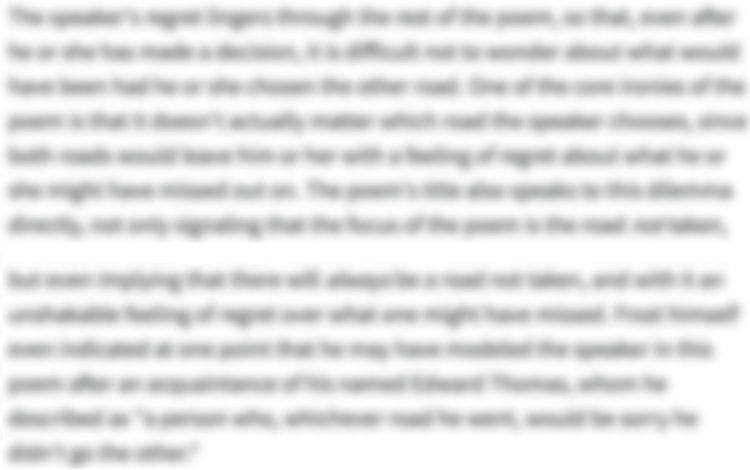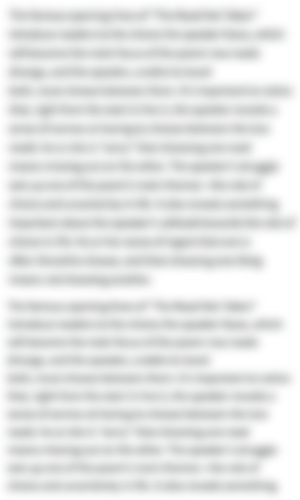-
“The Furthest Distances I've Travelled” Introduction
-
In Leontia Flynn's "The Furthest Distances I've Travelled," a speaker recalls the thrill of backpacking across the world and wonders how they ended up settling down into a more ordinary life. But even though their globetrotting days are behind them, the speaker's life is still filled with adventure: building close relationships, the poem suggests, is just as exciting and challenging as traveling the world. "The Furthest Distances I've Travelled" was published in Flynn's first poetry collection, These Days (2004).
-
-
“The Furthest Distances I've Travelled” Summary
-
The speaker says that, like a lot of people, the first time they hefted a heavy backpack and felt their backbone bending beneath it the way a meridian bends across the earth's curvature, they were struck by how absolutely right it seemed. Whether they were visiting a common tourist destination, navigating hidden mountain paths, going from Poland to Croatia, or sitting in the cold white rooms of distant airports, it was obvious as a voice over a loudspeaker that constant anonymous travel was the speaker's destiny.
The speaker isn't sure whether it was the warnings about antimalarial drugs—whose possible side include temporary insanity and going bald—that led them, not to a bank to send money with their rudimentary Lithuanian, but down to the local post office to deposit a little cash or an unemployment check. And they can't quite figure out why now, if they happen to find themselves shoving underwear into a bag, it's less likely that they're taking a bus across Wisconsin and more likely that they're catching up on laundry.
Still, when they tidy up their home and find unfamiliar underwear, movie tickets, some passing words jotted on a post-it note, or a little pressed flower hidden away in a drawer, they know that these things are their mementoes. From these fragments of previous relationships—such as this ragged sports sock—they know that the longest journeys they've been on have been those between themselves and the people they've had relationships with. The little odds and ends are their souvenirs from short vacations in other people's lives.
-
-
“The Furthest Distances I've Travelled” Themes
-

The Value and Difficulty of Relationships
In “The Furthest Distances I’ve Traveled,” the speaker compares the adventurous travels of their younger days to the even more daring distances they’ve traversed “between people.” Though the poem’s speaker has lived an adventurous life, backpacking all over the world, they’ve since discovered that such journeys aren’t the most difficult ones. Relationships, in this poem, are their own kind of journey: an effort to cross the gap between one person and another can be an even greater adventure than a trek across the wilderness.
Now that the speaker no longer backpacks to faraway places, their life sometimes seems a little bit muted to them. But sometimes, when they’re tidying up their house and throwing things away, they find all sorts of reminders of a different kind of excitement: past relationships. An “alien” pair of underwear, old movie tickets, a “tiny stowaway / pressed flower” and a “throwaway / comment—on a post–it" are as much “souvenirs” as anything the speaker picked up on their travels. Such “crushed valentines,” the speaker implies, bring up memories of lost loves.
Forming a relationship makes the speaker feel as if they’re “holidaying briefly” in someone else’s life, visiting a foreign place and trying to get to know it. In this, relationships are a lot like travel. The speaker has gone to great metaphorical “distances” to get to know and care about other people. Although the speaker only knew their past lovers for a time, it’s clear that these people had a lasting effect on their life, just as their travels did.
The speaker thus feels that “the furthest distances [they’ve] travelled” aren’t between places, but between people. They may not be trekking “between Krakow / and Zagreb” or taking anti-malarial drugs these days, but their relationships have provided similar thrills and challenges. While the “anony / mity” of travel excited them in their youth, it is the attempt to know and be known that makes their life now challenging and rewarding. A successful relationship, the poem hints, is even harder to navigate than a “sherpa pass”!
Where this theme appears in the poem:- Lines 1-32
-

Seeking Adventure vs. Settling Down
In “The Furthest Distances I’ve Traveled,” the speaker recalls the intense excitement they experienced the first time they picked up a backpack and began traveling the world. They remember the thrill of getting from place to place, whether it was a direct “path” or a more obscure one; adventure, they say, felt like their “destiny.” But nowadays, the speaker admits, they are more likely to be catching up on household chores than jumping on a bus. Though they have left the more active adventures of their youth behind, growing up and settling down has allowed them to appreciate the quieter adventures of everyday life and relationships.
The speaker remembers a time when the thrill of globetrotting was the most important part of their life. The first time they put on a backpack, the speaker says, they “thought: Yes. This is how / to live.” They got a sense of purpose—even “destiny”—from moving from place to place, regardless of whether they stayed “On the beaten track” or trekked to somewhere more remote. Their excitement, they recall, came “clear as over a tannoy” (or loudspeaker), suggesting that they felt completely certain this was the way they were meant to live their life.
Yet somewhere along the way, the speaker admits, their life became more rooted and ordinary. Looking around them, the speaker marvels at how different their daily life is now. Rather than wiring money from a Western Union in Lithuania, they find themselves running errands at an ordinary post office close to home. (Judging by the vocabulary—“giro,” “pants"—home for the speaker is probably in the UK or Ireland). And they’re more likely “to be doing some overdue laundry” than “catching a greyhound.” It’s clear their life has become much more settled since their traveling days.
Still, growing up and settling down doesn’t mean the speaker has lost their sense of adventure. The speaker reflects on the “souvenirs” they find while tidying up: “cinema stubs” and a “pressed flower amid bottom drawers” remind them of “crushed valentines,” words that suggest the speaker has had a busy romantic life. These little mementos of relationships suggest that a rooted life can offer its own thrills. Even if one doesn’t go on wild travels, relationships continue to make life exciting. In this way, the poem suggests that one doesn’t have to go to the ends of the earth to have an adventurous life. An ordinary, settled life offers its share of adventure.
Where this theme appears in the poem:- Lines 1-32
-
-
Line-by-Line Explanation & Analysis of “The Furthest Distances I've Travelled”
-
Lines 1-6
Like many folk, ...
... to live.As the poem begins, the speaker recalls the first time they shouldered a traveler's backpack. Their "spine / curved" beneath it, they say, like "a meridian"—an imaginary longitudinal line that passes over the earth's surface and connects its poles. This simile suggests that, right from the start, the speaker felt this backpack opened up the whole world to them. Their very body mirrored the shape of the globe they'd soon travel.
Upon feeling the weight of the backpack—and everything it signified—the speaker says:
I thought: Yes. This is how
to live. [...]In other words, under the weight of their backpack, the speaker immediately felt that they had found their life's purpose: to travel all over the world. This will be a poem about a call to adventure—and about what happens after that adventure ends.
The speaker will tell their tale in eight quatrains (four-line stanzas) of free verse. The lack of meter here, alongside a rough rhyme scheme of couplets (often in the loosest slant rhyme—for instance, "spine" and "meridian" share only that /n/ consonance), will make the speaker's voice feel colloquial and approachable, as if they're telling the reader a story over a drink.
-
Lines 6-8
On the beaten ...
... of scattered airports;

Unlock all 339 words of this analysis of Lines 6-8 of “The Furthest Distances I've Travelled,” and get the Line-by-Line Analysis for every poem we cover.
Plus so much more...
Get LitCharts A+ -
Lines 9-12
it came clear ...
... kind of destiny. -
Lines 13-18
So whether it ...
... or a giro; -
Lines 18-22
and why, if ...
... really beyond me. -
Lines 23-28
However, ...
... are my souvenirs -
Lines 29-32
and, from these ...
... in their lives.
-
-
“The Furthest Distances I've Travelled” Poetic Devices & Figurative Language
-
Simile
The poem's similes wittily connect the speaker's outer experiences to their inner ones.
For instance, consider this moment from the speaker's earliest traveling days:
Like many folk, when I first saddled a rucksack,
feeling its weight on my back—
the way my spine
curved under it like a meridian—The simile compares the bend of the speaker's back beneath their backpack to the imaginary longitudinal line that crosses over the earth's surface, connecting its poles. Besides painting a funny picture of the speaker hunching forward under a heavy bag, this simile suggests that the speaker felt an exciting sense of destiny as they shouldered that rucksack. Feeling that meridian curve in their spine, the speaker also knows in their bones that they'll travel all over the globe, from pole to pole.
In line 9, meanwhile, the speaker hears "some kind of destiny" calling to them as if "over a tannoy," a loudspeaker. Arriving right after the speaker's image of "scattered airports," this simile evokes the kind of crackly loudspeaker announcement one might hear in an airport—as if an airline desk were calling the speaker to their nomadic fate.
In both of these similes, the speaker uses the physical realities of travel to evoke the feelings and beliefs their adventures conjured up for them.
Where simile appears in the poem:- Lines 3-4: “my spine / curved under it like a meridian—”
- Line 9: “it came clear as over a tannoy”
-
Enjambment


Unlock all 265 words of this analysis of Enjambment in “The Furthest Distances I've Travelled,” and get the poetic device analyses for every poem we cover.
Plus so much more...
Get LitCharts A+ -
Caesura
-
Alliteration
-
Allusion
-
-
“The Furthest Distances I've Travelled” Vocabulary
Select any word below to get its definition in the context of the poem. The words are listed in the order in which they appear in the poem.
- Saddled
- Rucksack
- Meridian
- The beaten track
- The sherpa pass
- Zagreb
- Krakow
- Siberian
- Tannoy
- Larium
- Delirium
- Western Union
- Wiring
- Lithuanian
- Giro
- Holdall
- Smalls
- Greyhound
- Milwaukee
- Madison
- Evictions
- Pants
- Stowaway
Saddled-
(Location in poem: Line 1: “when first I saddled a rucksack”)
Put on. The word suggests that the rucksack has to be swung heavily over the speaker's shoulders as a saddle is swung over a horse's back.
-
Form, Meter, & Rhyme Scheme of “The Furthest Distances I've Travelled”
-
Form
"The Furthest Distances I've Travelled" is written in free verse, without a regular meter. However, it does use a roughly regular shape: its 32 lines are broken into eight quatrains (four-line stanzas). Though the consistent stanza length adds some structure and predictability to the poem, individual lines vary considerably. The shortest is only half a word long!
This variety, alongside lots of unexpected enjambments, mirrors the novelty and strangeness of the speaker's travels, upon which the speaker saw everything from the busy streets of "Krakow / and Zagreb" to a remote "sherpa pass." The surprises in the poem's shape also evoke the surprises in the speaker's life, up to and including the discovery that the "furthest distances" might be between one person and another, not between hemispheres.
-
Meter
The poem is written in free verse, so it doesn't have a regular meter. The lack of meter—along with the use of colloquial vocabulary like "pants" and "holidaying"—means the poem sounds as footloose as the speaker was in their younger days. It also makes the speaker's voice feel casual and conversational, as if they were just telling an anecdote to a friend.
-
Rhyme Scheme
The poem uses a straightforward rhyme scheme of couplets, like this:
AABB
Notice, however, that many of the poem's rhymes are slant, and often very faint: "spine" and "meridian" in the first stanza, for example, only share /n/ consonance, and "white" and "airports" in the second stanza share even more tenuous /t/ consonance. These less-than-perfect rhymes make the poem's musicality more subtle, especially since many lines are enjambed, discouraging the reader from overemphasizing the last words of lines and giving the poem a relaxed, conversational tone.
In the third stanza, the poet practically bends over backward to keep the rhyme scheme intact:
it came clear as over a tannoy
that in restlessness, in anony
mity:
was some kind of destiny.Here, the poet enjambs a line in the middle of a word—"anonymity"—in part so that the rhyme scheme doesn't get disrupted! This rhyme really only works on a visual level, though; reading the poem aloud, one will just hear three slant rhymes in "tannoy," "anonymity," and "destiny."
-
-
“The Furthest Distances I've Travelled” Speaker
-
The speaker is a one-time world traveler. The poem doesn't tell readers much about this person's identity or background, but their vocabulary ("rucksack," "giro," "pants" as in underwear) suggests they're from the UK or Ireland. (Flynn herself is from Northern Ireland.)
In their youth, the speaker was most excited by the thrill of "anony / mity"—that is, being unknown, a stranger in a strange land. They clearly loved an adventure and weren't scared to look for it either on or off "the beaten path."
Now that they're older, though, the speaker has settled down a bit. They're no longer hopping on buses and sitting in airports. Instead, they're at home, tidying up and recalling past relationships. The many keepsakes they unearth as they dig through "bottom drawers" suggest that, although they're no longer as physically daring as they used to be, they still find plenty of journeys to go on. Now, however, these journeys are "between people" rather than countries or continents.
-
-
“The Furthest Distances I've Travelled” Setting
-
Though they once traveled the world, the poem's speaker is now firmly planted at home. The poem doesn't say where that home is, exactly, but judging by the speaker's vocabulary, readers can guess it's probably somewhere in the UK or Ireland. Here, they spend their time doing "overdue laundry," running errands, and tidying up their home, sorting through ephemera of past relationships—in short, living a fairly humdrum and ordinary life.
The poem also evokes the speaker's more adventurous past. The speaker recalls places as far-flung as Poland, Croatia, Lithuania, and Wisconsin. And their mention of the dangerous side effects of "Larium," an anti-malarial drug, suggests that they at least considered traveled further afield to the countries in the southern hemisphere where malaria is prevalent.
The poem's larger point about place is that physical travel is only one way to cross great distances. Crossing the gap "between people" is its own kind of mighty journey.
-
-
Literary and Historical Context of “The Furthest Distances I've Travelled”
Literary Context
Leontia Flynn was born in County Down in Northern Ireland in 1974. Growing up, she was drawn to poems in school anthologies and began writing her own poems at the age of 14. At 16 her class studied Philip Larkin and he became one of her major influences.
Flynn earned an MA at Edinburgh University and then completed a Ph.D. on the poetry of Northern Irish poet Medbh McGuckian at Queen's University Belfast. Her other influences include Robert Lowell, John Berryman, and Paul Muldoon as well as Shakespeare and the Roman poet Catullus.
She published "The Furthest Distances I've Travelled" in her first collection, These Days, in 2004. This debut received much praise from critics and earned her the Forward Prize for best first collection. Fellow Northern Irish poet Colette Bryce wrote that These Days "is a landscape of shiftless youth, rented flats, bread-and-butter jobs and millennial angst." Thereafter, Flynn began working at the Seamus Heaney Centre for Poetry at Queen's University Belfast. She has since published three other books of poetry.
Broadly speaking, "The Furthest Distances I've Travelled" can be seen as belonging to a tradition of poems in which traveling is used as a metaphor for other aspects of life. In Flynn's poem, the journey "between people"—that is, the attempt to form relationships—is ultimately what's significant. Other poems that portray metaphorical journeys include Emily Dickinson's "Our Journey Had Advanced," where the journey is one from life into death and eternity; "The Journey" by Mary Oliver, where the speaker goes through both an outer and inner journey in order to save their own life; and W.B. Yeats's "Sailing to Byzantium," where the journey represents a symbolic quest for spiritual meaning.
Historical Context
"The Furthest Distances I've Travelled" was published in 2004—the same year that Facebook was launched, al-Qaeda bombed trains in Madrid, and the biggest earthquake in 40 years struck southeast Asia. But the poem doesn't directly address historical events such as these. Instead, it looks at the world through the eyes of a globetrotting young backpacker. To this speaker, the world is a place full of potential adventures, a place to be seen. Their simple decision to throw on a backpack and hit the road reflects the increasing ease of 21st-century travel: if this poem had been written a mere century earlier, there would have been no "scattered airports" or anti-malarial "Larium" to smooth the speaker's path.
Backpacking as a style of travel began with the "hippie trail" of the 1960s and '70s, a route between western Europe and South Asia. In the decades since, it's boomed in popularity among people in their late teens and early 20s. As the name suggests, backpackers travel with only what they can carry in a backpack. A low-cost form of travel, it typically involves taking trips longer than the standard week's vacation, staying in cheap accommodations like hostels or homestays, and using public transport to get between destinations.
-
More “The Furthest Distances I've Travelled” Resources
-
External Resources
-
The Poem Aloud — Listen to Flynn reading her poem.
-
Flynn's Critical Reception — Read a review of Flynn's first book.
-
An Interview with Flynn — Watch a 2018 video of Flynn talking about her work.
-
A Brief Biography — Read an introduction to Flynn's work from the Poetry Foundation.
-
-








